p.115
p.121
p.131
p.141
p.151
p.159
p.167
p.175
p.183
Polymer-Modified Mortars for Corrosion Protection at Offshore Wind Energy Converters
Abstract:
The importance of renewable energy for our world’s energy supply is steadily increasing. Starting last year, offshore wind parks are being developed along the German coastline following the success achieved in the onshore wind energy. The first German offshore wind energy park is be erected on the Alpha Ventus test field near the isle of Borkum, where the depth of the sea amounts to 30 meters. Due to the hazardous conditions associated with the sea water, many challenges regarding corrosion control have to be met. With the combined effects of sea water, varying moisture conditions and impact damages caused by ice and flotsam, the conventional methods of corrosion protection with mean thicknesses of 1000 μm will not suffice to protect the steel for an operating life expectancy of 25 years. As a result, the thickness of the various construction elements need to be increased beforehand leading to an excessive usage of steel. For the new corrosion protection system presented in this paper, a layer made of high performance mortar with a thickness of about ten millimeters will be sufficient to protect the steel. To unfold its protecting effect, the mortar needs to comply with stringent requirements such as exhibiting high resistance to chloride ingress, frost and abrasion.
Info:
Periodical:
Pages:
151-157
Citation:
Online since:
January 2011
Authors:
Permissions:
Share:
Citation:


